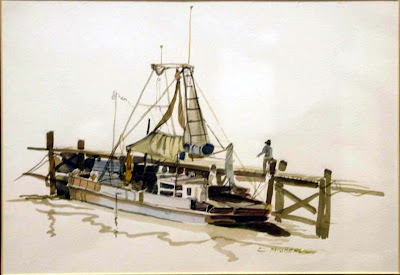All images and content are copyright © 2009 by Jamie E. Ambrose
_US_LR.JPG)
detail.JPG) Canyon Shades (top: full work, bottom: detail). Watercolor and oil ink. Signed; 1991. Matted/framed. Unmatted dimensions: approx. 20 by 14 inches/51 x 35cm.
Canyon Shades (top: full work, bottom: detail). Watercolor and oil ink. Signed; 1991. Matted/framed. Unmatted dimensions: approx. 20 by 14 inches/51 x 35cm. Badlands. Watercolor and ink. Signed; circa 1990. Matted/framed. Unmatted dimensions: approx. 21 by 14 inches/54 x 37cm.
Badlands. Watercolor and ink. Signed; circa 1990. Matted/framed. Unmatted dimensions: approx. 21 by 14 inches/54 x 37cm. Sycamore Sink. Watercolor and ink. Signed; 1991. Matted/framed. Unmatted dimensions: approx. 29 by 21 inches/72 x 54cm. This large work was one my father valued more highly than all others, due, one can only guess, to the untold hours he spent meticulously covering the original watercolor in millions of abstract line patterns. My mother found it too dark and brooding for her tastes, but it captures the essence of a natural Southern 'sink'.
Sycamore Sink. Watercolor and ink. Signed; 1991. Matted/framed. Unmatted dimensions: approx. 29 by 21 inches/72 x 54cm. This large work was one my father valued more highly than all others, due, one can only guess, to the untold hours he spent meticulously covering the original watercolor in millions of abstract line patterns. My mother found it too dark and brooding for her tastes, but it captures the essence of a natural Southern 'sink'..JPG)
detail.JPG) Woodland Cathedral (top, plus detail). Watercolor and ink. Signed; 1991. Matted/framed. Unmatted dimensions: approx. 22 by 17 inches/56 x 43cm. Look closely at this painting and you will find 'bromeliads' and 'ferns' hidden within what reminds me of a Southern pine forest on a bright autumn day...
Woodland Cathedral (top, plus detail). Watercolor and ink. Signed; 1991. Matted/framed. Unmatted dimensions: approx. 22 by 17 inches/56 x 43cm. Look closely at this painting and you will find 'bromeliads' and 'ferns' hidden within what reminds me of a Southern pine forest on a bright autumn day... The Spawn. Watercolor and oil ink. Signed; circa 198(7)8-1990. Matted/framed. Unmatted dimensions: approx. 22 by 17 inches/56 x 43cm. This is slightly earlier than the rest of the 'retirement period' abstracts, so may have been created during the last years of Ambrose’s tenure at William Carey College on the Coast. However, it clearly uses the same technique as the others; hence I have placed it in this grouping for now. Dimensions are a guess; I thought I had it catalogued already, as I knew it well – and completely forgot to measure it during the last encounter...
The Spawn. Watercolor and oil ink. Signed; circa 198(7)8-1990. Matted/framed. Unmatted dimensions: approx. 22 by 17 inches/56 x 43cm. This is slightly earlier than the rest of the 'retirement period' abstracts, so may have been created during the last years of Ambrose’s tenure at William Carey College on the Coast. However, it clearly uses the same technique as the others; hence I have placed it in this grouping for now. Dimensions are a guess; I thought I had it catalogued already, as I knew it well – and completely forgot to measure it during the last encounter...















US_LR.JPG)
USLR.JPG)


















